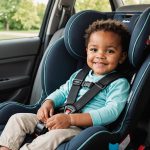Understanding Child Safety Seat Compatibility
Navigating the world of child safety seats can be challenging, but understanding the compatibility with vehicle safety systems is essential for ensuring your child’s safety. Child safety seats come in various types, from infant carriers to convertible and booster seats, each designed with specific features tailored to a child’s age and size. It’s crucial to select a seat that not only suits your child’s needs but also fits seamlessly with your car’s built-in safety systems.
Vehicle safety systems such as the ISOFIX or LATCH anchors are common, offering secure attachment points for child seats. To ensure a proper fit, always refer to your vehicle manual and the seat’s installation guidelines. Misconceptions about safety seat installation often lead to incorrect setups, compromising safety. For instance, many assume that tighter is always better, but an excessively tight fit can be as problematic as a loose one.
Additional reading : How Fog Lights Enhance Vehicle Safety in Harsh UK Winter Conditions
In practice, always verify the securely installed seat doesn’t move more than an inch in any direction. Familiarize yourself with both seat features and your vehicle’s safety systems to eliminate compatibility issues and protect your loved ones effectively.
Evaluating Vehicle Safety Systems
When considering vehicle safety features, it’s crucial to understand how airbags interact with child safety seats. Airbags are designed to protect adults; however, they can pose significant risks to children when safety seats are placed in the front passenger seat. The force of a deploying airbag can cause serious injury to a child, which makes rear seat placement preferable. It’s always advisable to deactivate front passenger airbags if your child’s safety seat must be positioned there, though this is not recommended.
Have you seen this : Maximize Your Parking Precision: Tips for Ensuring Your Vehicle’s Parking Assist Thrives in Narrow UK Spaces
Now, let’s examine seat belt compatibility with safety seats. Various types of seat belts exist, like lap belts and three-point seat belts, and not all are compatible with all types of child safety seats. Ensure your vehicle’s seat belts securely fasten the seat without excessive movement.
For vehicles that lack standard safety features such as side-impact airbags or modern belt systems, consider using portable safety gear. Portable child safety vests or harnesses can be lifesavers in these scenarios. Opt for retrofitted solutions if the budget allows—these additions could significantly enhance child passenger safety without the need for a new vehicle.
Installation Tips for Optimal Safety
When it comes to child seat installation, ensuring safety is paramount. Proper installation methods are critical to protect your child during travel. Start by reading the vehicle and seat manuals meticulously. An instruction oversight can lead to incorrect installation, compromising safety.
Proper Installation Methods
Harness the art of secure fastening techniques with these crucial steps. Begin with setting up the seat on the backseat, ensuring a snug fit against the vehicle seat. Check if your safety guidelines require the seat to be forward-facing or rear-facing, based on your child’s age and weight. Use body weight to press down and tighten belts for an absolutely secure hold.
Using LATCH vs. Seat Belts
Deciding between the LATCH system and seat belts can be perplexing. LATCH systems offer the benefit of simplicity and quick setup. However, their tether weight limit may require transitioning back to seat belts, which provide a higher weight capacity. Weighing these pros and cons, consider what best suits your safety guidelines and the specific seat model.
Adjustments for Different Vehicle Models
Vehicle models can influence adjustments. For SUVs, higher seat anchoring points might require different tether setups to maintain secure installation. Conversely, sedans could demand creative re-positioning for a tight fit. Tailor your approach to ensure every journey is a safe one.
Safety Standards and Regulations
When it comes to child safety seats, ensuring compliance with child safety regulations is crucial. These regulations are designed to protect children during car travels by setting forth specific guidelines on how child restraints should be manufactured and used.
Compliance standards play a vital role in distinguishing safety seats that meet mandatory safety criteria. These standards are enforced rigorously to ensure that all products maintain a baseline of quality and protection. Parents should always select seats that have reputable safety certifications to guarantee that they adhere to these standards.
Verifying compliance with local safety standards can often be done by checking for labels or marks indicating certifications such as those by the United Nations Economic Commission for Europe (UNECE) or the Juvenile Products Manufacturers Association (JPMA). These certifications indicate that the seat has undergone rigorous testing and meets the necessary safety criteria.
Moreover, it is essential for parents to stay informed about the latest updates to child safety regulations in their region as these can change over time. By ensuring compliance, parents can have greater peace of mind regarding their child’s safety in automobiles.
Recommended Child Safety Seats
When selecting top-rated child safety seats, several key criteria should guide your decision to ensure optimum safety and compatibility with vehicle safety systems. Primarily, the seat’s crash test ratings, ease of installation, and adjustable harness systems play a vital role.
Matching the compatibility with vehicle safety systems is crucial. Parents must ensure the seat aligns with their car’s LATCH (Lower Anchors and Tethers for Children) system or the vehicle’s seat belt pathways. This alignment is essential for correct installation and optimal protection during a collision.
Top-rated models currently excelling in safety and compatibility include the following:
-
Britax Boulevard ClickTight: Known for superior side-impact protection and an easy ClickTight installation system.
-
Chicco KeyFit 30: Offers high marks for simplicity in securing the seat and head safety features.
-
Graco 4Ever DLX: Transition-friendly, adapting from an infant seat to a booster, with integrated harness safety checks.
Before purchasing, consult resources like the National Highway Traffic Safety Administration (NHTSA) and manufacturer guidelines to verify specific safety seat manufacturer recommendations for your vehicle type.
Visual Aids and Resources
Understanding the installation of child seats can be challenging, but resources available can simplify the process. Leveraging resources like safety guides and videos can make the experience both informative and reassuring.
Diagrams and Charts
Diagrams offer a clear visual representation of installation processes. They provide step-by-step guidance, highlighting critical points such as belt paths and buckle placements. Charts often include detailed schematics, showing everything from anchor positions to recline angles. These aids are invaluable for visual learners who benefit from seeing each step laid out methodically.
Video Tutorials
Instructional videos further enhance learning by demonstrating techniques in real-time. They allow viewers to pause and replay sections, ensuring no detail is missed. Some of the most useful videos come from official manufacturers and child safety experts. These videos build confidence, showing first-hand all elements of proper installation, including attaching tethers and adjusting harnesses.
Manufacturer Guidelines Links
Links to manufacturer guidelines serve as another crucial resource. These documents are well-researched and authoritative, providing up-to-date safety seat regulations and recommendations. Users can download or reference these guidelines to ensure compliance with current safety standards, ensuring the security of their child’s seat installation.











